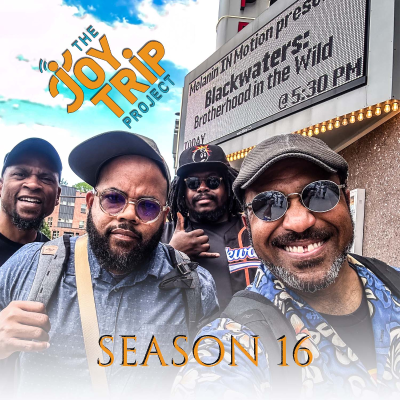
The Joy Trip Project
Podcast by James Edward Mills
This podcast is free to listen on all podcast players and the Podimo App without a subscription.
All episodes
110 episodesAfter 16 years of production, the Joy Trip Project has worked hard not to endorse political candidates. With a single exception in the last Wisconsin Senate race, I’ve intentionally kept my opinions to myself. As a professional journalist, it is my obligation not to reveal my personal bias regarding any political party or partisan issue. Instead, it is my job to report on the events of our world in as objective a manner as possible. Even in this incredibly divisive and polarizing campaign season, I have recounted few details on the respective candidacies of former President Donald Trump and Vice President Kamala Harris. Although I’ll vote for one candidate, based on my personal beliefs publicly, I’ve been silent on these matters. That’s not going to change. As a news organization it is our duty to convey to our audience the facts of any story with neither bias nor prejudice so that one can draw their conclusions, and cast their vote based on the information we’ve gathered. Since we tend to focus on issues of environmental preservation, I believe that a summary of the two candidates’ history of protecting the natural world can best serve the interests of our readers and listeners. Donald Trump and Kamala Harris have strikingly different records on the environment.
Hosted by James Edward Mills, this series delivers each day in the month of February a compelling audio story via podcast in about 60 seconds. Each narrative offers a brief glimpse into the life and times of Black men and women who have shaped our cultural identity. The series is called Unhidden Minute. I hope you’ll join us.
Immediately following my return from Washington D.C. - I mean on the flight home – I was inundated with kind words of support and condolences for the demise of my Christmas Tree. Due to excessively high winds early in last week of November 2023, it is indeed true that the beautifully decorated holiday tree provided to the White House by the National Park Service sadly fell over. News reports in photographs showed the tree lying on its side. But as I graciously replied to each of these thoughtful notes, I found great comfort in the knowledge that the 63-foot Norway Spruce I had followed from the Monongahela National Forest of West Virginia to our nation’s capital, The People’s Tree, stood proudly on the west lawn of the U.S. Capitol Building.Immediately following my return from Washington D.C. - I mean on the flight home – I was inundated with kind words of support and condolences for the demise of my Christmas Tree. Due to excessively high winds early in last week of November 2023, it is indeed true that the beautifully decorated holiday tree provided to the White House by the National Park Service sadly fell over. News reports in photographs showed the tree lying on its side. But as I graciously replied to each of these thoughtful notes, I found great comfort in the knowledge that the 63-foot Norway Spruce I had followed from the Monongahela National Forest of West Virginia to our nation’s capital, The People’s Tree, stood proudly on the west lawn of the U.S. Capitol Building.
For those of us who really love bicycles, I think what we enjoy most is the sense of freedom we get from travel on the open road under our own power. This mechanical device allows us to engage both our minds and bodies to pedal long distances on just two wheels so that we can explore the landscape of the modern world. But through our journeys over lightly trafficked rural roads, as we roll past obscure old towns and villages, we can also reveal the compelling memories of the not-so-distant past. As a modern-day explorer, there's a man who rides a bike along gravel paths and asphalt highways across time and space and into the pages of history. Erick Cedeño: My name is Eric Cedeño. Some people know me as the Bicycle Nomad. JTP: For many years, Eric Cedeño has traveled thousands of miles by bicycle across North America. As a cyclist carrying his own gear from one town to the next, he reimagines the excitement and enthusiasm of human powered transportation toward the end of the 19th century. Back then, even the United States Army thought that the bicycle might change how human beings travel from place to place. Erick Cedeño: There was a big craze. People were going crazy about the bicycle, the technology, about the bicycle. And the army realized that they needed other methods of transportation to be successful. They only had the cavalry back then, and they knew that bicycles were cheaper than horses. Easier to maintain than a horse. They could go further than a horse could. And also, there were quite in battlefields. So they understood the power of the bikes and they wanted to adapt a bicycle corps. JTP: In 1896, U.S. Army Lieutenant James Moss came up with the idea to conduct an experiment to see if the bicycle could one day be used to replace the horse. In order to prove the concept, moss recruited a platoon of 20 soldiers. Erick Cedeño: Fort Missoula, Montana, is where that was formed. Lieutenant Moss approached the Army and says, I have the perfect man to do this experiment. And he did. Luckily for him, he had the Buffalo Soldiers out of the 25th Infantry out of Fort Missoula. Erick Cedeño The Bicycle Nomad photo by Josh Caffrey JTP: At the time, more than 30 years after the end of the Civil War, there were stationed there an all-Black unit of enlisted men known collectively as the Buffalo Soldiers. These men who fought the Plains Wars of westward expansion and sadly participated in the displacement of Native people, were given the opportunity for a peacetime mission into the American heartland. Led by Lieutenant Moss, a white officer. Over the next two years, from 1896 to 1897, the Buffalo Soldier Bicycle Corps would make three expeditions across the West. In 2022, Eric Cedeño retraced the route that they traveled from Fort Missoula, Montana, to Saint Louis, Missouri. The distance of more than 1900 miles. In the retelling of their story through physical reenactment, the Bicycle Nomad takes us on a journey back in time. In his travels following the path of the Buffalo Soldiers, Cedeño not only celebrates the accomplishments of black Americans from our past, but also inspires further exploration of our history that is too often overlooked. I'm James Edward Mills, and you're listening to The Joy Trip Project. Title photo by Josh Caffrey Erick Cedeño in Missouri photo by Josh Caffrey Erick Cedeño's passion for exploration began at a very early age. Erick Cedeño: Since I was a kid, I've always loved history. And I have a story where my mom took me to Mexico to see the pyramids of the Mayan and Aztec civilization. We went to Mexico just for that. She hired a tour guide that took us and told us the history. Now, I'm 12 years old. I have read some of that, those books. And to be walking the steps of ancient civilization just changed my world.
The protection of public land requires the broad ranging vision and leadership of federal service professionals at the highest levels. As the 19th Director of the National Park Service Charles F. Sams III is guiding the management of a complexed agency that oversees the protection of 63 National Parks and more than 420 individual monuments, battlefields, lakeshores and grasslands. A member of the Confederate Tribes of the Umatilla Indians, Sams is the first Native American to serve as the administrator of the memorial sites that preserve our natural history and enduring national heritage. After a long career in the U.S. Navy in times of both war and peace as well as the creation of career opportunities for aspiring stewards of the natural environment, Sams now dedicates his commitment to public service by encouraging the next generation of National Park Rangers. By building a corps of passionate interpreters to effectively tell a more comprehensive story of our culture as a united people, he’s a helping to pave a diverse and inclusive pathway of preservation well into the future.[/vc_column_text][/vc_column][/vc_row] "You're never going to meet a more passionate group of people who are dedicated to mission than the National Park Service Rangers and their staffs out there," Sams said. "And what they really need is a leader who will advocate for them to ensure they have the funding so they can can go about doing the preservation of flora and fauna and telling America stories." In recent months since the passage by Congress of the Great American Outdoors Act, also known as GAOA, there are new opportunities to affirm the priorities of natural resource and heritage protection through the National Park Service. By permanently providing financial resources for the Land And Water Conservation Fund, the federal government is poised to make profound investments in the people and places that define our identity as a nation. Now that he’s coming to the end of his first year on the job, I had the chance speak to Sams and have him reflect upon his tenure so far as well as the role that the NPS can play in the shaping our way forward. I’m James Edward Mills. And you’re listening to, The Joy Trip Project. National Park Service Director Charles Sams (Middle) stands with Mosaics In Science Interns at the U.S. Department of the Interior Building in Washington D.C. (photo by James Edward Mills) JTP Well, first of all, thank you very much for taking the time to to chat with me and to share a little bit about your experience in the management of public land. My first question is a very basic one. Tell me where you from and how you how you got to the position that you're in now. Sams So I'm from Oregon originally. I was born in Portland, Oregon, but raised on the Umatilla Indian Reservation in northeast Oregon, right along the Umatilla River, which was feeds into the big river, which is now known as the Columbia, that we know as the Necheewana. And I very fortunate to grow up in a very well-educated household. My parents had attended and graduated junior college, which was very rare to have two native parents who had actually not only attended, but graduated. And so education has always played an important part and also a freeing of oneself by having a good education. In addition to being surrounded by a number of elders, my grandfather and a number of tribal elders who raised me in a much more traditional and cultural sense of the Cayuse and Walla Walla people. JTP And from that experience, how did you get into public service? Sams Well, public service is expected in our family. We are supposed to give back more than we take, which is a simple principle. We also come from a group of people that believe that we have limited wants with unlimited resources, which is the exact opposite, which, you know, it's funny, since I have a business degree that tells me that I have unlimited wants...
Available everywhere
Listen to Podimo on your phone, tablet, computer or car!
A universe of audio entertainment
Thousands of audiobooks and exclusive podcasts
No ads
Don't waste time listening to ad breaks when listening to Podimo's content.



















